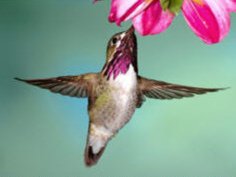According to one recent article that I read, there are several species of hummingbirds which are declining in population. This post will tell you which species these are, try to offer some insight into why this is happening and tell you can help provide a habitat for hummingbirds.
According to the Audubon Society’s Watch List of Rare and/or Declining Birds, the are four species of hummingbirds found there: Allen’s, Costas, Calliope, and Rufous. Over the past 40 years, the Rufous Hummingbird has declined an alarming 58 percent!
The increase in population and urban development is playing a huge role in the loss of the hummingbird’s habitat. Logging efforts can also effect the hummingbirds habitat.
If you want to help the hummingbirds there are many things you can do to ensure that there is an abundant food supply available. These suggestions can be done individually or in combination with each other.
Make sure to make your yard a hummingbird habitat that these birds will want to visit. These suggestions listed below should help you successfully do this.
Your hummingbird garden should have a long season of overlapping bloom. Some plants that do so include the following: petunia, annual red salvia, autumn sage and shrimp plants, or the firebush.
It is always best to plant flowers and plants which are native to your area of the country. You can find out information concerning the specific plants that grown in your area and attract hummingbirds by talking with someone from a plant nursery that is located where you live.
Your flower garden should have areas of sun, partial sun, and shade. If the area of your yard where you want to create the hummingbird habitat is sunny most of the day, then you need to plant trees and shrubs. If the area is entirely in the shade, you will want to open up the area to let large patches of sunlight in. Having areas that allow both sun and shade is necessary to grow a wide variety of plants.
Your flower garden needs to consist of many levels of vegetation. The area should have some tall trees, some medium-height trees, some flowers, some grassy areas, as well as some shrubs. These different levels will provide the hummingbirds a variety of choices of where to feed or where to perch to rest or roost.
You plant a wide variety of flowers, including those that are known to attract hummingbirds as well as others. You should select a variety of flowers that will bloom at different times, because there will always be something flowering. The flowers will serve two very important purposes: they will provide a source of nectar for the hummingbirds, and they will also attract insects on which the birds will feed.
It is also important for your flower garden to have a source of water available for the hummingbirds. The use of a birdbath is one way to do this. The birdbath should have a very shallow water depth to allow the birds to stand in the water if they choose to do so. Adding some small flat rocks to the birdbath will create different water depths within the birdbath.
Having a wide variety of plants will provide the female hummingbird a wide variety of nesting materials from which to choose.
Your hummingbird garden should also contain some perches so the hummingbirds can survey the territory. You might want to create some perches that give the birds a good view over the flowers.
The other thing you can do to provide a food source for the hummingbirds is to place hummingbird feeders throughout your yard. There are several things to keep in mind with regard to the use of hummingbird feeders.
It is very easy to make your own nectar solution by using 1 part white granulated cane sugar to 4 parts water. If you choose to make your own homemade nectar solution, you should bring the solution to a boil for 1 1/2 minutes and then let it cool down. Now you have a mixture much more similar to that of the flower nectar.
Nectar solutions should be changed quite often, about every three days, because hot weather can cause rapid bacterial growth.
It is not necessary to add food coloring, especially if the feeder has a red blossom at the feeding point. Red food coloring is unhealthy for hummingbirds.
Honey should not be used to feed hummingbirds because it attracts bees and favors the growth of a black fungus that causes a fatal liver and tongue disease in hummingbirds.
It is sad that some hummingbird species are declining in population. Those of us who enjoy these beautiful birds can help provide a hummingbird habitat by doing the things mentioned in this post.
